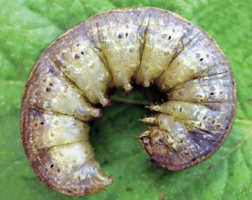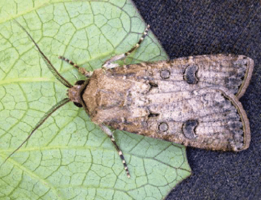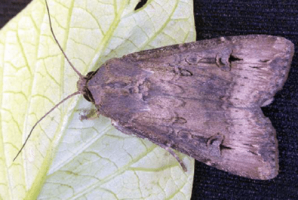Host plants
Cutworms are polyphagous and attack most vegetable crops in addition to a wide range of other crops such as cereals, chicory, cotton, tobacco, ornamentals, eucalyptus, pine and wattle trees. Many weeds and grasses are common alternative hosts.
Damage
Cutworms are especially troublesome in sandy soils and home gardens. They are both foliage and root/tuber-feeders. Although they damage plants in various ways, they most commonly sever stems completely near the soil surface, hence their vernacular name. Seedlings are particularly vulnerable because one cutworm may topple several in an evening. Larvae can usually be found at the base of affected plants, just below the soil surface at a depth of not more than 50 mm. They will also feed on roots of plants if encountered; some larvae burrow even deeper and will attack tubers by chewing deep holes into them, as illustrated.
Cutworms are sporadic pests. They usually occur in low numbers, affecting single plants over a large area. However, on occasion they may invade young crops or seedlings causing yield loss or the destruction of entire stands.
Life history
Cutworms and their moths are nocturnal and seldom seen. The caterpillars are usually only encountered when gardeners work in the soil or when inspecting the soil near damaged plants.
Based on available information, the life cycle of the four species treated here would appear to be much the same. Agrotis ipsilon females deposit eggs in clusters on foliage and may lay up to 2000 eggs in their lifespan. Eggs take 3-6 days to hatch. The number of larval instars varies, but there may be up to nine. The duration of the larval stage varies between 3-6 weeks or much longer in cold environments. Final instar larvae tunnel down into the soil to a depth of up to 120 mm to pupate. Moths emerge from pupae after 1-3 weeks or longer in winter. The duration of the life cycle is 1-2 months.
Agrotis segetum is one of the most common cutworms in southern Africa. Female moths lay approximately 1000 eggs that hatch within a few days in summer. The larval stage lasts about three weeks, while the pupal stage lasts as little as 12 days.
Natural enemies
Few diurnal predators attack cutworms because of their soil-bound and nocturnal nature. Ground beetles, soil fungi and nematodes may play a part in keeping cutworm numbers low.
Management
Cutworms readily feed on weeds and sanitation is therefore important, usually well ahead of planting time. Crops in low-till systems, where weeds often occur, are more prone to attack. When weeds are removed, the cutworms may crawl considerable distances during the night in search of new feeding or hiding sites.
Cutworms do not move from plant to plant underground. They emerge at night and crawl along the soil surface to find plants, after which they burrow into the soil next to the plant stem. Baits are therefore effective when applied to control cutworms, including baits applied as granules on the ground.








